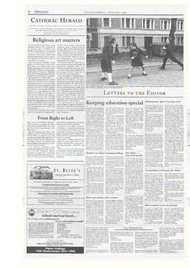Page 10, 26th April 1996
Page 10

Report an error
Noticed an error on this page?If you've noticed an error in this article please click here to report it.
Tags
Share
Related articles
Putney To Mortlake A Mid-week Impression
Classified Advertisements
You Can Have It Both Ways In Switzerland
Ryedale Is Unspoilt Rural England
A Wonderland At The Crossroads N/ Europe
Saxon splendour
VISITORS To RICHMOND head for the river. On a clear, sunny after
noon walkers tread the grassy tow-path and families picnic in the water meadows. The view from the grand terrace is a delight: boats glide up river matching the slow and stately procession of white swans; children throw bread to the ducks and ladies of a certain age take tea. It is a timeless, evocative place.
But walk away from the river and the character of Richmond changes. Narrow, winding streets, Georgian brick cottages and stylish homes create a village of hidden delights. Camellia trees just breaking into bloom, wrought iron Victorian lamp posts and cobbled sunlit passages. This is The Vineyard, named in memory of the twisting vines which once graced this hillside.
St Elizabeth of Portugal stands here; an elegant Georgian church with a tall verdigris spire. The Mission at Richmond was founded in 1793 by French emigre clergy fleeing persecutinn in revolutionary France. They, it is said planted the vines on this land and sowed the seeds for a resurgence of Catholic faith and practice. The French built a chapel here but it was an Englishwoman, Elizabeth Doughty, who provided the funds to build this fine church.
The Doughty family made their money in finance and property development. In the social climate of the time, the redoubtable Elizabeth was a rarity; a successful business woman and, with the death of her father in 1796, mistress of her own household. She had been a guarantor of the old chapel from 1804 and in the 1820s ordered that negotiations proceed to purchase the land freehold and build a church.
Miss Doughty's interests extended well beyond the philanthropic. In 1824 she published a set of 'Regulations' which were to be observed at all times at the 'New Chapel' a copy to be 'Fairly written on parchment and kept constantly hung up in the Sacristy'. She stipulated that 'A Female servant', to be paid £30 a year, was to be kept constantly to clean the chapel and presbytery, light and attend the chapel fires and wait on the priest. "I haven't seen that female servant for a long time," mutters parish priest Fr Philip Mathiasp. Tall and rangy he disappears off to dig out another reference book. The presbytery is light, the rooms gracefully proportioned. Miss Doughty's strictures have not been observed; Fr Mathias doesn't have a housekeeper and a comfortable maelstrom of books and papers strew the table.
He came to Richmond in 1985 and relishes the history and traditions of this parish. He shows me the original registers from the 18th century. We leaf through the frail books, musty and yellowed with age, admiring the slender copperplate and Latin inscriptions. John Butt, first Catholic Bishop to the forces and 4th Bishop of Southwark, was baptised here we find the entry for 1826, his sponsors John Adams and Catherine Holland. Newspaper cuttings from 1819 record a great Catholic procession through Richmond. "Non-Catholics looked on reverently in the presence of such solemnity and fervour," reads Fr Mathias. "The priests gave benediction from the roof of the church."
There's a certain irony in his voice. One of his first tasks here was to cope with the full scale restoration of the roof. "Do you remember what happened in October 1987? This place looked like a bomb had hit it." The hurricane tore through temporary scaffold ing, the metal twisted into a parody of modern art, hurling Jumps of parapet to the ground. For months they said Mass amidst a forest of scaffolding poles.
The original box structure of the church was extended in 1903 under the direction of architect Frederick Walters with further decorative work commissioned from GoodhartBenda'. Fr Mathias replaced olive-green and black with parchment coloured walls. Pale duck egg-blue panels grace the high vaulted nave ceiling. The colours are reflected in the decoration of the sanctuary. A beautiful, ornate baldechino frames the high altar in blue and gold, contrasting with the warm pink and ochre marble. It is a cool and restful church.
Touches of gilt outline sculpted friezes and the edges of Our Lady's marble dress in the Lady Chapel. High above, the initials of Elizabeth entwine; her memory writ in plaster, scarlet and gold. The font is in St Joseph's chapel; he stands in carved splendour holding the lily and the Church of Rome. On the other side of the sanctuary a simple chapel is dedicated to the Sacred Heart.
The stations of the cross and the mysteries of the rosary are painted in an unusual strip that circles the church. The signature powder-blue and stylizing look familiar. They were painted, says Fr Mathias, by Joseph Ledger who went on to become a chief designer for Wedgwood in the 60s. A tree stands between each station. At the 12th it is barren, its leaves fallen; they are restored after the 14th to symbolise the Risen Christ.
Looking back towards the choir-gallery light floods in from the high windows; the church echoes, our voices repeating in the cold air, as the chimes of the sacristy clock ring through the open space. 'We'll hear the Angelus soon".
Walking back towards the train station, Fr Mathias points out the river, a shining strip of silver dancing with light. Richmond was originally named Shene (Sheen), the Saxon word for brightness and splendour. Nothing has changed; it's still a beautiful and inspir
ing place. Christina White
blog comments powered by Disqus













